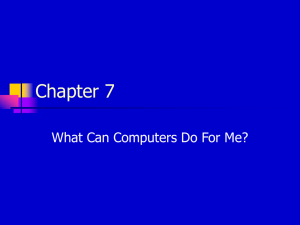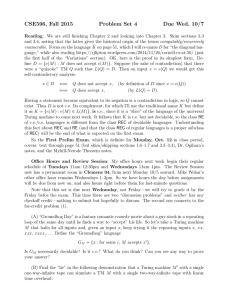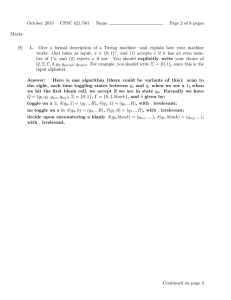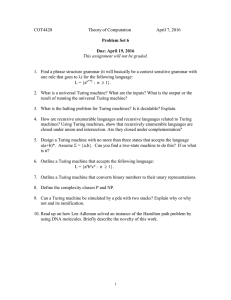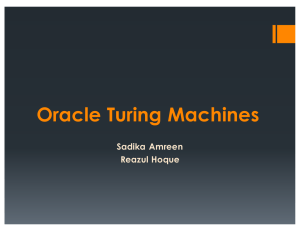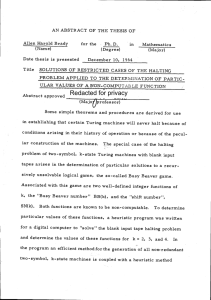1 The Big Picture SI472/SI430 Final Exam Study Guide 2007
advertisement
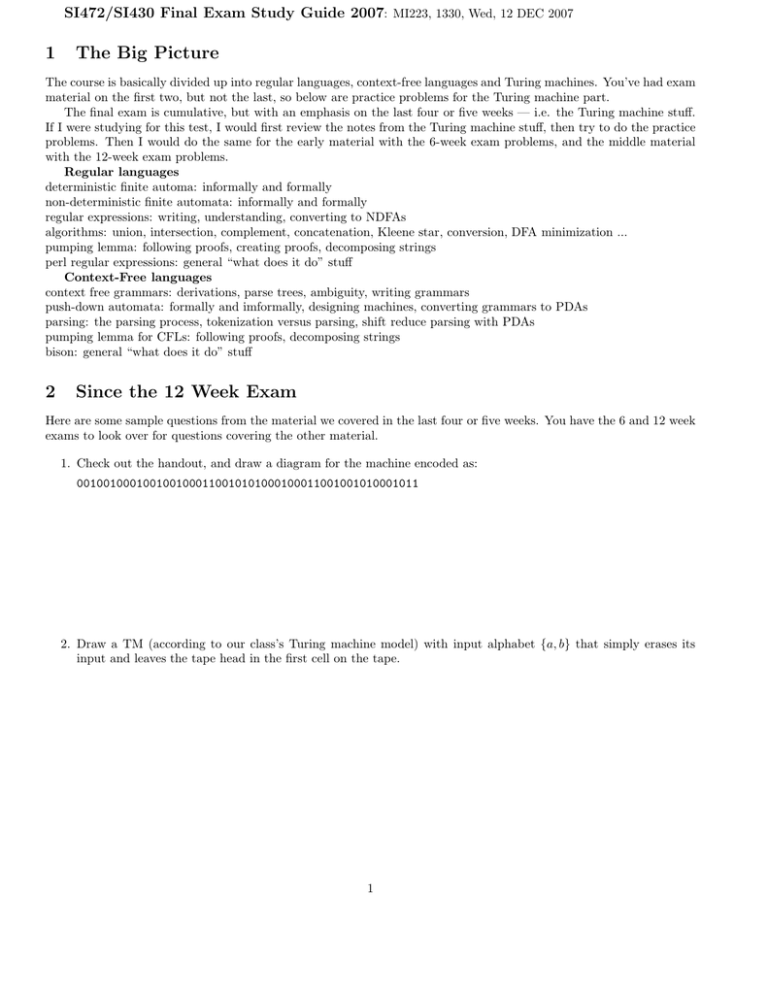
SI472/SI430 Final Exam Study Guide 2007: MI223, 1330, Wed, 12 DEC 2007
1
The Big Picture
The course is basically divided up into regular languages, context-free languages and Turing machines. You’ve had exam
material on the first two, but not the last, so below are practice problems for the Turing machine part.
The final exam is cumulative, but with an emphasis on the last four or five weeks — i.e. the Turing machine stuff.
If I were studying for this test, I would first review the notes from the Turing machine stuff, then try to do the practice
problems. Then I would do the same for the early material with the 6-week exam problems, and the middle material
with the 12-week exam problems.
Regular languages
deterministic finite automa: informally and formally
non-deterministic finite automata: informally and formally
regular expressions: writing, understanding, converting to NDFAs
algorithms: union, intersection, complement, concatenation, Kleene star, conversion, DFA minimization ...
pumping lemma: following proofs, creating proofs, decomposing strings
perl regular expressions: general “what does it do” stuff
Context-Free languages
context free grammars: derivations, parse trees, ambiguity, writing grammars
push-down automata: formally and imformally, designing machines, converting grammars to PDAs
parsing: the parsing process, tokenization versus parsing, shift reduce parsing with PDAs
pumping lemma for CFLs: following proofs, decomposing strings
bison: general “what does it do” stuff
2
Since the 12 Week Exam
Here are some sample questions from the material we covered in the last four or five weeks. You have the 6 and 12 week
exams to look over for questions covering the other material.
1. Check out the handout, and draw a diagram for the machine encoded as:
0010010001001001000110010101000100011001001010001011
2. Draw a TM (according to our class’s Turing machine model) with input alphabet {a, b} that simply erases its
input and leaves the tape head in the first cell on the tape.
1
3. Define what is meant by “the language semi-decided by TM M .”
4. T/F (Justify your answer): A Turing machine is such a simple model, it can’t tell us anything about sophisticated
and complex modern computers.
5. T/F (Justify your answer): There is no limit on what can be done with computers.
6. Draw the TM defined by the following tuple:
{q0 , q1 , q2 }, {0, 1}, {0, 1}, q0
q1
q2
0
1
(q1 , , R) (q1 , , R) (h, , S)
, q0
(q1 , 0, R) (q1 , 1, R) (q2 , , L)
(q2 , , L) (q2 , , L) (h, , S)
7. Getting back to the first square of a TM is always a big pain in the neck, because you have to take care to
mark it, otherwise you’ll fall off the end of the tape. Suppose we wanted to add a new feature to our Turing
machine model. In addition to the Left, Right and Stay tape head moves we currently each transition, we’ll allow
a “Back-to-square-one” move which, in a single step, returns the tape head to the first square on the tape.
Refer to the handout and give a formal definition of this augmented Turing machine model. It is enough to tell
me what changes to the tuple/configuration/=⇒ text on the handout are necessary. You need not copy all the
stuff that stays the same.
2
8. Consider the following TM:
a;a,R
a;a,L
b;b,L
q1
a,L
R
q3
b
a;
;a
;b
,R
b;
,R
a
q0
S
L
b,
b;b,R
R
q4
halt
q2
• For input abba what configuration does this machine halt in? Your answer should be a configuration according
to our definition! (see handout). (Hint: writing down the entire sequence of configurations in the computation
would make partial credit a lot more likely!)
• Give a concise english description of what this machine accomplishes — i.e. for any input, not just abba.
9. Consider the following mystery algorithm:
Input: TM M1 = (Q1 , Σ1 , Γ1 , δ1 , s1 ), TM M2 = (Q2 , Σ2 , Γ2 , δ2 , s2 ), where Q1 ∩ Q2 = ∅
Output: TM M = ({$} ∪ Q1 ∪ Q2 , {0, 1} ∪ Σ1 ∪ Σ2 , {0, 1} ∪ Γ1 ∪ Γ2 , δ, $), where
(s1 , x, R)
if
p = $ and x = 0
if
p = $ and x = 1
(s2 , x, R)
δ1 (p, x)
if
p ∈ Q1 and x ∈ Σ1
δ(p, x) =
if
p ∈ Q2 and x ∈ Σ2
δ2 (p, x)
(p, x, S) otherwise Note that this causes an infinite loop!
Give a concise english-language description of what this algorithm accomplishes, i.e. “Given two TMs M1 and
M2 , this algorithm produces a machine M such that ...”. Hint: Suppose M1 replaces all as with bs, and suppose
M2 replaces all bs with as. What would the machine M produced by this algorithm do for input 0abba? How
about for input 1abba?
3
10. Let G be the grammar
S −→ aT bb | λ
T −→ bRa | ab
R −→ T a | cc
with start symbol S. Let w = ababaabb. Decompose w into uvxyz as the pumping lemma for CFGs would do, i.e.
so uv k xy k z ∈ L(G) for all k ≥ 0. Show your work!
4

